The incidence of different types of diabetes is on the rise in the United States and worldwide. In the United States, the Centers for Disease Control and Prevention reported a 217% increase in the prevalence of diabetes in those 0–44 years of age and a 150% increase in those 65–74 years of age from 1990 to 2009. While the rise in cases of Type 2 diabetes is perhaps most striking, it appears that the incidence of Type 1 diabetes is increasing as well.
But Types 1 and 2 aren’t the only types of diabetes out there: There’s also gestational diabetes, maturity-onset diabetes of the young, and the so-called Type 1.5 diabetes, not to mention prediabetes, which raises a person’s risk of developing Type 2 diabetes. All types of diabetes are characterized by high blood glucose levels, and all can lead to complications, but the causes of different types of diabetes may be different, and the treatments can be different, too. Here is a run-down of the characteristics of various types of diabetes.
Type 1 diabetes
Type 1 diabetes is an autoimmune disorder in which the immune system attacks and destroys the insulin-producing beta cells in the pancreas. As a result, the pancreas produces little or no insulin. Type 1 diabetes is also characterized by the presence of certain autoantibodies against insulin or other components of the insulin-producing system such as glutamic acid decarboxylase (GAD), tyrosine phosphatase, and/or islet cells.
When the body does not have enough insulin to use the glucose that is in the bloodstream for fuel, it begins breaking down fat reserves for energy. However, the breakdown of fat creates acidic by-products called ketones, which accumulate in the blood. If enough ketones accumulate in the blood, they can cause a potentially life-threatening chemical imbalance known as ketoacidosis.
Type 1 diabetes often develops in children, although it can occur at any age. Symptoms include unusual thirst, a need to urinate frequently, unexplained weight loss, blurry vision, and a feeling of being tired constantly. Such symptoms tend to be acute.
Diabetes is diagnosed in one of three ways — a fasting plasma glucose test, an oral glucose tolerance test, or a random plasma glucose test — all of which involve drawing blood to measure the amount of glucose in it.
Type 1 diabetes requires insulin treatment for survival. Treatment may also include taking other drugs to prevent kidney damage or to treat diabetes-related conditions such as high blood pressure.
Type 2 diabetes
In Type 2 diabetes, there are two main underlying reasons for high blood glucose: insulin resistance, a condition in which the body does not use insulin efficiently, and insufficient insulin secretion by the pancreas. People with Type 2 diabetes usually do not show signs of autoimmune disease.
Type 2 diabetes usually develops in adults, but it is now occurring with alarming frequency in children. The growing epidemic of obesity in children is believed to be a major contributor to the increase of Type 2 diabetes in children. Symptoms of Type 2 diabetes are generally the same as those for Type 1 diabetes, but they may be much milder. In fact, many people with Type 2 diabetes are unaware that they have it. Other symptoms may include wounds that heal slowly, frequent infections, and, in adults, sexual dysfunction, including impotence.
Treatment for Type 2 diabetes may include taking oral medicines to decrease insulin resistance and/or increase insulin secretion and taking other drugs to treat any diabetes-related conditions; it may also include taking insulin. Attention to diet and regular physical activity are important treatment components. Weight loss can also help to reverse insulin resistance and lower blood glucose if a person is overweight.
Type 1.5 diabetes
When a person has characteristics of both Type 1 and Type 2 diabetes, he is sometimes said to have “double diabetes,” or Type 1.5.
Among the people who do not require insulin at diagnosis (most of whom are assumed to have Type 2 diabetes), some show autoantibodies, especially antibodies against islet cells and GAD. Initially, the term “latent autoimmune diabetes in adults” (LADA) was applied to this subset of people with diabetes. It has also been dubbed “slow-progressing Type 1 diabetes.” In the late 1990s, some researchers coined the term “Type 1.5 diabetes,” because it had features of both the major types.
Further study of people who at least initially do not require insulin yet have autoantibodies has revealed some distinct variations, leading some researchers to subdivide those placed under the umbrella term LADA into three groups: Type 1–LADA, Type 1.5 or “double” diabetes, and Type 2 diabetes with autoantibodies. Under this scheme, people with Type 1–LADA are thought to have a more slowly progressing form of Type 1 diabetes. Like people with Type 1 diabetes, people with Type 1—LADA have autoantibodies and are usually not obese. Although they may initially be able to get by with diet therapy and oral diabetes medicines, they usually need to use insulin within about five years of diagnosis because of the destruction of their beta cells.
People with Type 1.5 diabetes are said to have “double” diabetes because they show both the autoimmune destruction of beta cells of Type 1 diabetes and the insulin resistance characteristic of Type 2 diabetes. People with Type 1.5 have autoantibodies and gradually lose their insulin-producing capability, requiring insulin within 5–10 years of diagnosis. As their insulin resistance suggests, many people with Type 1.5 diabetes are obese or overweight.
People in the third group are obese or overweight with insulin resistance like most people with Type 2 diabetes, and they also have autoantibodies. However, they still manage to produce insulin for more than five years after diagnosis and can continue to manage their diabetes with diet, exercise, and oral medicines. It is suspected that the autoimmunity in these people is very mild.
Some researchers suggest screening anyone newly diagnosed with Type 2 diabetes for GAD antibodies. In the landmark United Kingdom Prospective Diabetes Study (UKPDS), most study subjects with Type 2 diabetes between 35 and 45 years old who tested positive for antibodies against both GAD and islet cells progressed rapidly to insulin dependency. Some researchers have also suggested that anyone who tests positive for GAD antibodies be screened for autoantibodies to thyroid and adrenal cells, because like people with Type 1 diabetes, people with Type 1.5 diabetes seem to be at higher risk of having other autoimmune diseases.
The jury is still out on the best way to treat Type 1.5 diabetes. Maintaining tight blood glucose control may help to slow the destruction of the beta cells (and delay insulin dependency) as well as reduce the risk of long-term diabetic complications.
Gestational diabetes
Gestational diabetes is diabetes diagnosed during pregnancy. It may disappear after childbirth, but it is likely to develop again during subsequent pregnancies. Gestational diabetes affects about 4% of all pregnancies, resulting in roughly 135,000 cases in the United States each year. Women with gestational diabetes are also at a higher risk of developing Type 2 diabetes later in life.
Gestational diabetes usually develops during the second or third trimester of pregnancy. Certain hormones released at that time work against the action of insulin and cause insulin resistance. If the pancreas is unable to produce enough insulin to meet the increased need, gestational diabetes develops. Women with gestational diabetes are at increased risk of giving birth to babies with respiratory problems or high birth weights.
Gestational diabetes is most likely to affect women who are over 25, are overweight, have a close family member with diabetes, or belong to an ethnic group at high risk for diabetes (African-Americans, Asian-Americans/Pacific Islanders, Hispanic Americans/Latinos, and Native Americans fit into this category). These women should be screened for gestational diabetes between the 24th and 28th week of pregnancy.
Screening consists of a oral glucose tolerance test, or OGTT, which is designed to determine how well a person’s body handles glucose. The woman drinks 50 grams of pure glucose dissolved in water. One hour later, her blood glucose level is checked. A blood glucose level of 140 mg/dl or higher indicates that the woman may have diabetes, and another test is done. In this test, the woman fasts, then ingests 100 grams of glucose. Her blood glucose level is checked up to four times: once before ingesting the glucose and at one hour, two hours, and three hours afterward. If any two of these values is equal to or above a certain level (95 mg/dl while fasting, 180 at one hour, 155 at two hours, or 140 at three hours), then the diagnosis of diabetes is confirmed.
Women diagnosed with gestational diabetes must strive to keep their blood glucose levels under control for their own health and that of their baby. Diet, exercise, and insulin are the most common treatments. Doctors do not typically prescribe oral drugs as a treatment for gestational diabetes.
Gestational diabetes usually disappears when the stress of pregnancy is over. However, women who have had gestational diabetes should continue to eat a healthy diet, avoid gaining weight, and exercise regularly after giving birth due to their higher risk of developing Type 2 diabetes.
Maturity-onset diabetes of the young
Usually called MODY, maturity-onset diabetes of the young is a type of diabetes associated with single genetic defects that lead to impaired functioning of the insulin-producing beta cells of the pancreas. It generally causes mild, chronic high blood glucose at an early age — usually before age 25.
MODY is distinctly different from either Type 1 or Type 2 diabetes. In MODY, the primary problem is a defect in insulin secretion. When the pancreas does not produce enough insulin, abnormalities in glucose transport and metabolism result. This in turn leads to high blood glucose, which can contribute to insulin resistance. The impaired secretion of insulin seen in MODY is similar to the deficiency found in Type 1 diabetes, but unlike Type 1 diabetes, MODY develops slowly and does not completely destroy the ability of the pancreas to secrete insulin. However, it impairs insulin secretion enough so that the body cannot adequately control blood glucose levels from one moment to the next.
So far, 14 types of maturity-onset diabetes of the young have been identified; they are labeled MODY1 through MODY14. Each type of MODY represents a specific, usually inherited, genetic defect affecting insulin secretion. MODY is treated very much like Type 2 diabetes — with diet and exercise, often in combination with blood-glucose-lowering pills, insulin, or both. Researchers can now test the children of adults with MODY and detect genetic predispositions for MODY before the children develop high blood glucose, allowing early intervention and possibly delay of the onset of diabetes.
Treating the different types of diabetes
The goal in any diabetes treatment is to keep blood glucose and blood pressure levels as close to normal as possible. Chronically high blood glucose levels can damage many parts of the body, including the eyes, kidneys, nerves, and cardiovascular system. In women who are pregnant, high blood glucose can cause macrosomia, or a baby that is larger than normal. High blood pressure can also do widespread damage to the body’s organs. However, studies have shown that “tight” blood glucose and blood pressure control lowers the risk of complications significantly.
Blood glucose level can be monitored at home with a blood glucose meter. The American Diabetes Association (ADA) recommends that most people with diabetes aim for the following treatment goals: The target blood sugar goal before a meal is 80 mg/dl–130 mg/dl. When using a meter that gives plasma glucose levels, the target goal before a meal is between 90 mg/dl and 130 mg/dl. (Whether a meter gives whole blood glucose values or plasma glucose values should be indicated in the literature that comes with the meter.) People who use insulin are generally advised to check their blood glucose level more frequently than those who don’t.
Another blood test that helps to evaluate blood glucose control is the glycosylated hemoglobin (HbA1c) test. This blood test is usually done in a doctor’s office or medical laboratory, although there are some home tests on the market. The ADA recommends that people with diabetes in general aim for an HbA1c reading below 7%, while individuals and their doctors consider aiming for readings even lower than the general goal of below 7%. Measuring HbA1c every 3—6 months is recommended.
Blood pressure is usually measured at the doctor’s office, although some people monitor their blood pressure at home. The ADA treatment goal for blood pressure is below 140/90 mm Hg.
Acute complications of diabetes include hypoglycemia (low blood glucose), diabetic ketoacidosis (a life-threatening condition characterized by high blood glucose, ketones in the blood and urine, and dehydration), and hyperosmolar hyperglycemic state (a life-threatening condition characterized by very high blood glucose and dehydration). Long-term complications include atherosclerosis (hardening and narrowing of the arteries), neuropathy (nerve damage), retinopathy (eye disease), and nephropathy (kidney disease).
Prediabetes
Prediabetes is a condition in which blood glucose levels are elevated, but not yet within the range classified as diabetes. It is also known as impaired fasting glucose (IFG) or impaired glucose tolerance (IGT). The new term was inaugurated by the U.S. Department of Health and Human Services (HHS) and the ADA in March 2002 to promote public understanding of this increasingly widespread problem. According to the American Association of Endocrinologists (AACE), roughly 86 million Americans had prediabetes in 2016. Studies have shown that most people with blood glucose levels in the prediabetes range go on to develop Type 2 diabetes within 10 years; the condition also raises the risk of having a heart attack or stroke by 50%. Prediabetes can be controlled, and in many cases even reversed, through lifestyle changes.
Prediabetes can be detected by either of the two standard tests currently used to diagnose diabetes. In the fasting plasma glucose test (FPG), a person fasts overnight and then has blood drawn for testing first thing in the morning, before he eats. People with a fasting blood glucose level of 100 to 125 mg/dl are considered to have prediabetes. A fasting blood glucose level over 125 mg/dl indicates diabetes. (A second test must be done on a subsequent day to confirm a diagnosis of diabetes.)
In the oral glucose tolerance test (OGTT), a person’s blood glucose is tested once after an overnight fast and again two hours after he has consumed a special, glucose-rich drink. A normal blood glucose level two hours after the drink is below 140 mg/dl; an elevated blood glucose level in the range of 140 to 199 mg/dl indicates impaired glucose tolerance, or prediabetes. A blood glucose level 200 mg/dl or higher two hours after the drink indicates diabetes. (Again, a second test must be done on a subsequent day to confirm diabetes.)
People who are overweight (defined as having a body-mass index of 25 or higher) and are age 45 and up are considered at risk for prediabetes and should be screened. People under the age of 45 who are overweight should also be screened if they have one or more of the following risk factors for diabetes: high blood pressure, a family history of diabetes, low high-density lipoprotein (HDL, or “good”) cholesterol and high triglycerides, a history of gestational diabetes or giving birth to a baby over 9 pounds, or belonging to one of the racial or ethnic groups that is at increased risk for Type 2 diabetes (African-Americans, Native Americans, Asian Americans/Pacific Islanders, and Hispanic Americans/Latinos). If a person is tested for prediabetes and his results are within the normal range, the ADA recommends that he be retested every three years. If a person is diagnosed with prediabetes, he should be screened for Type 2 diabetes every one to two years.
Prediabetes can also affect children and adolescents. A study published in The New England Journal of Medicine in March 2002 found that 25% of obese children and 21% of obese adolescents tested had blood glucose levels within the prediabetes range. Currently, not much is known about how to prevent or delay the onset of Type 2 diabetes in children. The widespread screening of younger people for prediabetes, therefore, is not currently called for by major health organizations. However, in 2000, the American Academy of Pediatrics recommended diabetes testing for obese children who also have two or more of the additional risk factors for diabetes mentioned earlier.
Prevention
Not all cases of diabetes can be prevented, but many can, and ongoing research may point the way toward preventing even more.
In adults who have been diagnosed with prediabetes, lifestyle changes can delay or prevent the development of full-blown Type 2 diabetes. Results from the Diabetes Prevention Program, a study conducted by HHS and involving more than 3,000 participants, showed that a 5% to 7% weight loss lowered the incidence of Type 2 diabetes by 58%. The weight loss was achieved through dieting (cutting fat and calories) as well as exercising moderately (most participants chose walking) for at least 150 minutes a week. Use of the oral diabetes drug metformin (brand name Glucophage and others) also helped to delay the onset of diabetes in some study participants; however, it was not as effective as diet and exercise. A more recent study, called the DREAM study, showed that use of the drug rosiglitazone (Avandia) also reduced the risk of developing Type 2 diabetes in people at risk. However, drug use as a treatment for prediabetes is not recommended at this time.
Efforts to prevent Type 1 diabetes in humans have so far been largely unsuccessful, but numerous studies, many of them part of a group of studies called Type 1 Diabetes TrialNet, continue to work toward that end.





